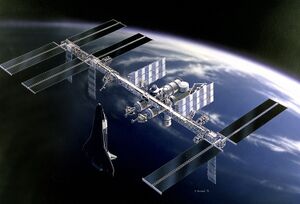Space Station Cheonji: Difference between revisions
mNo edit summary |
No edit summary |
||
| Line 36: | Line 36: | ||
With the first station module, the [[Cheonji Module]], launched in 1999, initial construction of the station was completed in August 4, 2013, although new modules to replace older modules launched in the 2000s is set to begin in 2020. Original plans to replace the station with the newer [[Space Station Changgong]] had begun in 2018, although the Zhenia Space Agency currently plans to operate both space stations simultaneously as a part of the low-earth orbital network, possibly as assembly points for outer space exploration. | With the first station module, the [[Cheonji Module]], launched in 1999, initial construction of the station was completed in August 4, 2013, although new modules to replace older modules launched in the 2000s is set to begin in 2020. Original plans to replace the station with the newer [[Space Station Changgong]] had begun in 2018, although the Zhenia Space Agency currently plans to operate both space stations simultaneously as a part of the low-earth orbital network, possibly as assembly points for outer space exploration. | ||
==Purpose== | |||
==Construction History== | |||
===Manufacturing=== | |||
===Assembly=== | |||
The assembly of Space Station Cheonji initiated in December 1999, with the launch of the [[Cheonji Module]] near the current orbit of the space station; subsequent modules were delivered via numerous [[Mirinae Space Shuttle]] missions and manufactured robotically into the Cheonji Module, which was eventually designated as the mission control center of the entire station. By 2019, both through {{wp|extravehicular activity|EVA}} and the deployment of the [[Cheonryong Robotic Arm]], a total of 175 parts have been assembled to form the station. | |||
==Operation== | |||
==Mission Modules== | |||
==Cost== | |||
==See Also== | |||
{{Template:Zhenia_NavBox}} | {{Template:Zhenia_NavBox}} | ||
Revision as of 06:32, 24 January 2020
 | |
| Station statistics | |
|---|---|
| COSPAR ID | Template:COSPAR |
| SATCAT no. | 50001 |
| Call sign | Cheonji, Station, Central |
| Crew | Fully crewed: 6 Currently aboard: 12 (ZSA Expedition 21) |
| Launch | 21 December 1999 |
| Launch pad | |
| Mass | ≈ 479,725 kg (1,057,613 lb) |
| Length | 72.0 m (236.2 ft) |
| Width | 100.7 m (330 ft) |
| Height | ≈ 19.8 m (65 ft) |
| Pressurised volume | 906.08 m3 (31,998 cu ft) |
| Atmospheric pressure | 101.3 kPa (29.9 inHg; 1.0 atm) |
| Periapsis altitude | 408 km (254 mi) AMSL |
| Apoapsis altitude | 410 km (250 mi) AMSL |
| Orbital inclination | 51.64 degrees |
| Orbital speed | 7.66 km/s [ 27,600 km/h; 17,100 mph ] |
| Orbital period | 92.68 minutes |
| Orbits per day | 15.54 |
| No. of orbits | 112,277 as of October 2019[update] |
| Orbital decay | 1.8 km/month |
Space Station Cheonji (Modern Zhenian: 천지 우주정거장), is a Zhenian space station operating at low earth orbit since 1997 to the present, operated by the Zhenia Space Agency. As the world's largest artificial satellite in orbit as well as the largest asset currently owned by the Government of Zhenia, it primarily serves as an orbital laboratory for microgravity and space environment and an orbital communications center for space missions by the Zhenia Space Agency. It completes one orbit around the planet in around 93 minutes and finishes more than 15 orbits a day.
With the first station module, the Cheonji Module, launched in 1999, initial construction of the station was completed in August 4, 2013, although new modules to replace older modules launched in the 2000s is set to begin in 2020. Original plans to replace the station with the newer Space Station Changgong had begun in 2018, although the Zhenia Space Agency currently plans to operate both space stations simultaneously as a part of the low-earth orbital network, possibly as assembly points for outer space exploration.
Purpose
Construction History
Manufacturing
Assembly
The assembly of Space Station Cheonji initiated in December 1999, with the launch of the Cheonji Module near the current orbit of the space station; subsequent modules were delivered via numerous Mirinae Space Shuttle missions and manufactured robotically into the Cheonji Module, which was eventually designated as the mission control center of the entire station. By 2019, both through EVA and the deployment of the Cheonryong Robotic Arm, a total of 175 parts have been assembled to form the station.

